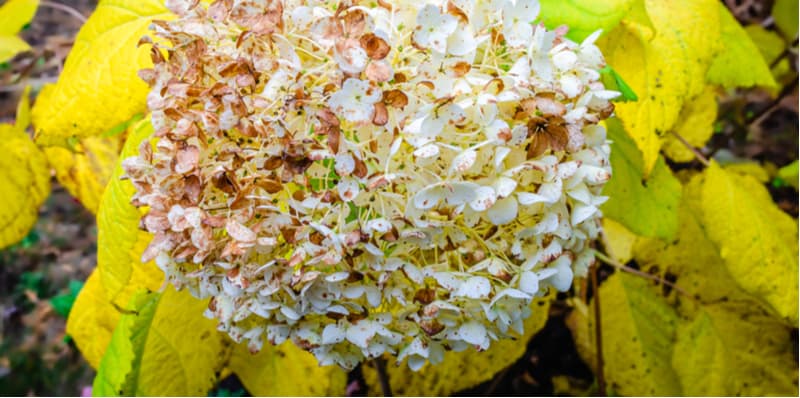Not known Details About Hydrangea Leaves Turning Yellow
Wiki Article
Facts About Hydrangea Leaves Turning Yellow Uncovered
Table of ContentsThe 9-Second Trick For Hydrangea Leaves Turning YellowThe Only Guide to Hydrangea Leaves Turning YellowNot known Factual Statements About Hydrangea Leaves Turning Yellow The Best Strategy To Use For Hydrangea Leaves Turning Yellow
One possibility is that the plant is not getting sufficient sunlight. During the winter season, the days are much shorter, and the sunlight is not as extreme, so make sure to place your Hydrangea in a spot where it will certainly access least 6 hours of sunshine every day. An additional factor for Hydrangea yellow fallen leaves in winter months can be excessive water.Ultimately, the fallen leaves may be turning yellow due to temperature tension. Hydrangeas like cooler temperatures, so if the plant remains in a place that gets too warm or too chilly, the fallen leaves will transform yellow. If you assume temperature anxiety may be the problem, try relocating your Hydrangea to a different area or securing it from the aspects with a burlap wrap.
New development will be observed in early spring, when you'll see environment-friendly vegetation sprouting from stems that may have shown up dead. If your fallen leaves are turning brown in spring or summer season, there are most likely other aspects at play. Hydrangea Leaves Turning Yellow. The precise reasons depend upon the range and their growing conditions, however in basic, brown hydrangea fallen leaves are an indication of dehydration and wilting in the warm
In the spring when the mercury stays relatively low, they'll do fine. When things warm up over the summer season however, time spent in the early mid-day rays can cause untold damage.: Grow your hydrangeas in a place where they'll get sunshine in the mornings or evenings, yet not during the peak hours.
The Main Principles Of Hydrangea Leaves Turning Yellow
Wilting is triggered by absence of dampness, meaning there are a few great techniques to make use of to stop this from taking place. Offer your hydrangeas a healthy glug of water every couple of days when the temperature levels are climbing up high, and treat the soil to much better keep moisture. After sprinkling, a dab of compost around the base of each plant need to assist with this by keeping dampness in the soil.This interferes with fungis spores from clearing up. "The Botrytis fungi grows in awesome and wet conditions, so stay clear of bathing the entire plant when watering and simply water at the origins," shares Roy Nicol, a Master Gardener - Hydrangea Leaves Turning Yellow. If you've missed the opportunity for prevention and are handling an infection you ought to remove all dead or drastically contaminated fallen leaves from the plant and destroy them to stop Get More Information further spread
As a basic general rule, we recommend removing fallen leaves when they are 50% brownish or greater. While browning triggered by any type of reason can not be turned around, taking the rehabilitative activity explained above will motivate the plant to grow new fallen leaves so the damaged fallen leaves either fall off naturally or can be removed by the garden enthusiast.
Hydrangeas ought to be sprinkled only when the leading couple of inches of soil are dry, and should be offered a detailed saturating each time. Underwatered hydrangeas are most likely to have yellow, wilting, and drooping fallen leaves.
Getting My Hydrangea Leaves Turning Yellow To Work
The method you fix hydrangea leaves turning yellow relies on the essential issue triggering the yellow leaves. This can be difficult to figure out, however when you do you will be able to change your plant care as necessary to care for the problem. As discussed previously, a common problem with hydrangeas is nutrition shortages.During the optimal growing season, you need to sprinkle at a rate of concerning 1 inch per week. If you are fretted about not correctly sprinkling your hydrangeas, there are a pair of things you can do. Adding compost to the base of the plants over the root zone help to control the temperature around the hedge and retain water in the soil.
If it is too severe, some plants will never recuperate from transplant shock and will certainly continue to decline until they die. Minimize transplant shock by including as lots of origins as feasible when digging up your plant to relocate. Make certain to offer more water than common in the weeks adhering to growing to help your plant recoup and expand brand-new origins.
Hydrangea Leaves Turning Yellow for Dummies
To prevent spreading fungal illness, make certain to thouroughly tidy and sanitize any kind of trimming devices before and after use. Finally, you can try to purge the roots with water to remove excess fertlizer.
If you do not water your hydrangea plant for even more than a week, the leaves will begin transforming yellow. Fungal conditions that strike the plants often tend to show indications on the roots and the leaves of the plant.
Origin rot occurs when virus use up the root cells as hosts and quit the cell from operating. Otherwise cared for, this disease can ultimately bring about the plant dying. Leaf spot is another fungal illness that can target hydrangea. It leads to the fallen leaves turning yellow and the look of brownish official statement and purple spots on the leaves.
Report this wiki page